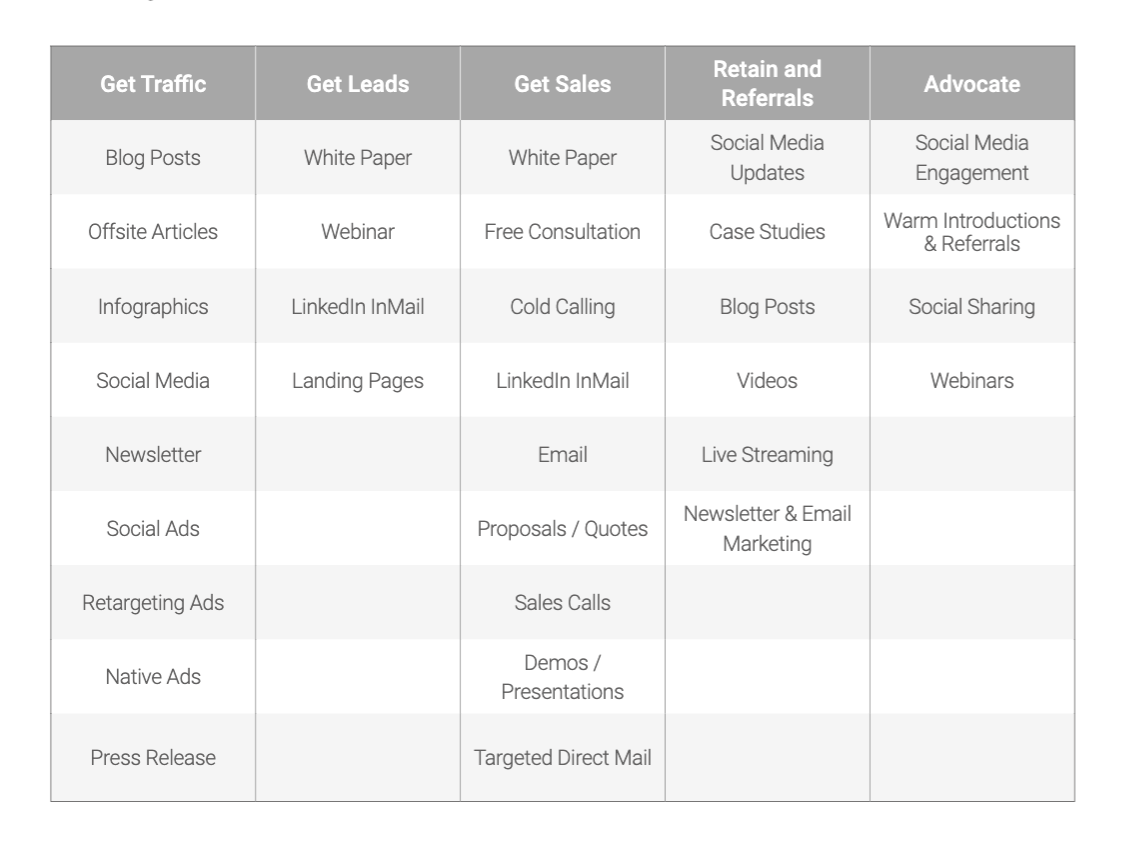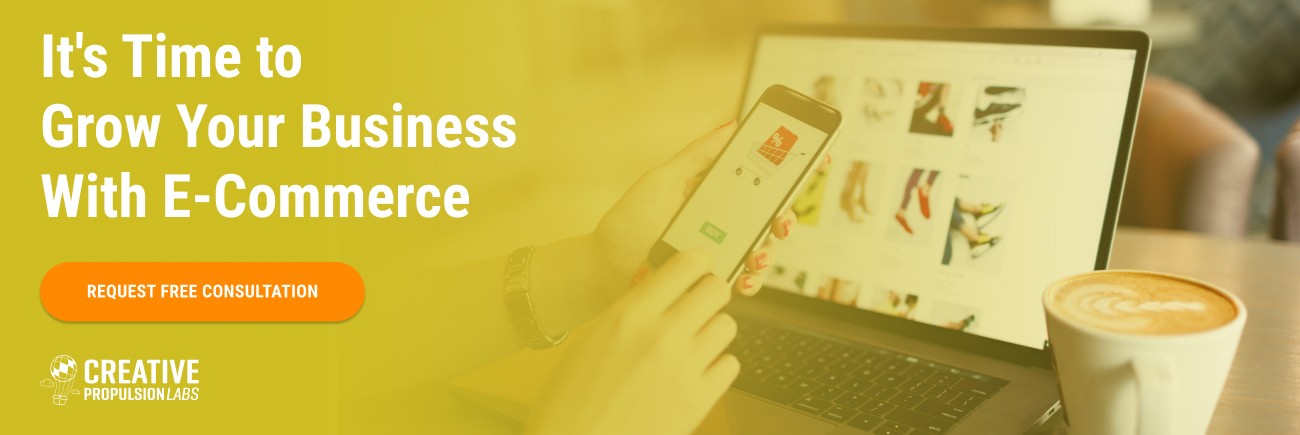KEY TAKEAWAYS
-
A B2B sales funnel, or buyer funnel is the path you’re going to use to drive your target audience through the steps necessary to complete the intended action on your page.
-
Well-designed landing pages can be a vital tool in attracting new B2B customers, converting their initial excitement into sales, and if all goes well, repeat clients.
-
B2B marketing often targets a smaller potential client base making it more expensive to run ads. This higher cost of acquisition often results in leads that are much more successful in converting.
-
Create captivating content that captures the attention of your B2B traffic and helps to convert traffic into leads.
-
Automated email marketing lets you set up and send out one or multiple email sequences catered to specific audiences and behaviors, nurturing your leads, and turning them into customers.
-
Some of the most successful B2B traffic generating strategies include paid search, and email marketing.
-
In order to truly maintain an efficient B2B sales funnel, businesses need to be willing to collect valuable feedback from customers and then implement changes based on that information.
Often, B2B companies rely on the “handshake” method of sealing a deal - that is to say, meetings, tradeshows, live demos, and presentations. While personable and quaint in it’s traditional roots, this method is not always feasible, and often can cause companies to miss out on the results of marketing traffic, which can lead to more sustainable, long-term growth.
This, however, can be fixed in a few quick steps by establishing an efficient and effective sales funnel. But where do you start?
If you are looking to expand your B2B audience and craft an effective marketing campaign, our team at Creative Propulsion Labs has drafted this quick guide to supercharge your B2B marketing efforts.
Set Up a Good Funnel
Your business needs a good funnel.
According to Salesforce, a full 68% of companies have not identified or attempted to measure a sales funnel, and the same survey showed that a whopping 79% of marketing leads are never converted into sales.
A B2B sales funnel, or buyer funnel is the path you’re going to use to drive your target audience through the steps necessary to complete the intended action on your page.
It is important to set up a clear and direct funnel for your B2B business since, in order to prevent the loss of customers and leads. But how do you complete this crucial step? In this article, we’ll give you a simple 5 step breakdown to help you create and optimize your B2B sales funnel.

1. Create Optimized Landing Pages
Well-designed landing pages can be a vital tool in attracting new B2B customers, converting their initial excitement into sales, and if all goes well, repeat clients.
Companies that use between 10-15 landing pages usually see a 55% increase in sales leads.
Most users access content via a smart device, so one of the most important tips to bear in mind is to develop user-friendly, mobile-optimized landing pages that maintain your site speed and visually engage with your visitors. Doing this will also increase the likelihood of return visits.
Break down the evolution of mobile marketing.
Make sure your landing pages function correctly, verifying all links work, all CTA buttons are easy to find, and all content is easy to locate. You can easily create landing pages that convert.
Website users, especially B2B ones, want to see clear, direct information that explains the relevance of your product or service to their business needs. Be clear to establish those connections early and maintain them throughout your site and marketing campaigns. Deliver valuable content on pages designed to lead B2B customers in the direction of your end goal of conversions.
Ensure that your landing pages correctly funnel guests toward a clear action:
-
Landing pages should lead site visitors in the direction of your Call-to-Action.
-
Your Call-to-Action should be clear, visible, and accessible to visitors.
-
All of your website forms should be up to date, separating your leads from just visitors in order to more accurately impact your conversion rate.
For more crucial elements every website should have, click here.
2. Generate Traffic to Your Landing Pages
61% of companies sited “generating traffic and leads” as their top marketing challenge. (source: 2018 State of Inbound Report)
Following are some of the most successful marketing strategies in the industry:
Paid Search Marketing
B2B marketing often targets a smaller potential client base making it more expensive to run ads.
This higher cost of acquisition may seem fruitless, but consider that those leads are often much more successful in converting. So while it may be more expensive to advertise on the front end, your clients (though fewer) will spend more money, making marketing worthwhile.
Content Marketing
Maintaining quality, sought-after content is paramount to any website. Generating information, answering relevant questions, and providing meaningful user-friendly navigation will all ensure your visitors convert and come back. Within B2B markets, this is especially important, as your content should tie to its unique business applications.
Using long-tail keywords and SEO-heavy content in blog articles, on landing pages, and in website metadata will help generate natural or organic site traffic to your landing pages.
Email Marketing
One of the most important strategies of getting your business out there will be through a well-crafted email welcome series and follow-up email campaigns, but more on that, later.
Learn more about automated email sequences here.
3. Convert Your Traffic into Leads
So you have the traffic and you have your landing pages. What now? Well, now it’s time to create, curate and capture. You see, the first two steps are critical, but they won’t get you very far without the vital incentive that bridges traffic to leads.
For this, you’ll need to create captivating content that captures the attention of your B2B traffic and encourages them to trade their email address or contact information in exchange for the information you are providing. Think of this as your first transaction with this new potential customer or client.
Be sure to use your understanding of your target audience well as you will need to provide content that is relevant, valuable, and insightful.
These resources, or lead magnets, can take shape in the way of informative landing pages with strong calls-to-action, white papers, newsletters, infographics, or other solution-based content.

See Our B2B Small Business Contingency Plan here.
From a consumer perspective, free white papers, tip sheets, and other such resources are almost irresistible to download and easy to consume. From a business perspective, you’ll be establishing your B2B business as a reputable and informed resource, developing a relationship with your audience while highlighting your products or services.
Best of all, this non-invasive soft-sell strategy works surprisingly well.
4. Create an Email Drip Campaign
Email marketing has an average return rate of $38 for every $1 spent.
Now that you have your leads - thanks to your effective landing pages and traffic generating strategies, it’s time to put them to use. For this, we like to use automated email sequences.
Email sequences offer a wide range of benefits to B2B business owners.
-
Establish a relationship and build trust with your customers
-
Highlight and steer leads to your strongest content
-
Position yourself as an invaluable resource by providing reliable and informative content
-
Increase sales by promoting your content at the end of the sequence
-
Gather more leads and gain more exposure as subscribers forward your content
Automated email marketing lets you set up and send out one or multiple email sequences catered to specific audiences and behaviors, nurturing your leads, and turning them into customers.
These series of emails can be time-based or triggered by a customer’s interaction with your business or website, such as joining your mailing list, downloading some of that curated content we talked about, purchasing a product or service, or even more passive interactions including browsing behavior and shopping cart abandonment.
When creating your email content, be sure to keep these tips in mind:
-
Add a catchy and interesting headline/subject line. Businesses receive a deluge of email spam, so ensure your content stands out. And once they click, you want to keep them paying attention.
-
Outline and deliver content clearly and quickly. Be familiar and kind, but also lead with the competitive advantages, clearly explaining how your product/service will benefit their business, whether that benefit is saving their company time and money or increasing product value and credibility.
-
Consider your industry needs and what the important competitive advantages are to such a company. Then, build around that.
-
Don’t forget to ensure your links work to drive traffic to landing pages set up to work fluidly with the email campaign. Target your information to reflect across omnichannel solutions, so visitors to your site, whether on a computer or mobile device, experience consistency from email to landing page content.
5: Track and Tweak As Needed
By this point, you should already start seeing your strong leads turn to conversions. But that doesn’t mean you’re done. It is critical that you continue to analyze and adjust your strategies to ensure that there are no holes in your funnel.
In order to truly maintain a model of success, businesses need to be willing to collect valuable feedback from customers and then implement changes based on that information. As such, customers will trust in the credibility of your business and one way to do that is setting up a good CRM.
Get a Good CRM
Your next step in setting up your B2B platform is finding a good CRM, or Customer Relationship Management system.

Customer Relationship Management systems use data to better understand and target your customers, tracking interactions with current customers and visitors which allows for a better understanding and analysis of actions and behaviors to anticipate and meet customer needs.
Some examples of popular CRMs include Hubspot, Salesforce, and Oracle, which collect and store information and data to be used in the second phase to improve B2B.
The data produced by the CRM can then be used to improve your business functions. With it, you can track feedback, attack sales channels, and increase overall sales.
CRMs allow you to target SEO and ads, considering content and print material production to include for current and future events.
At the end of the day, watching your metrics, analytics, and sales numbers will ensure that your funnel is always relevant and working efficiently.
Summation
Follow these steps to supercharge your platform for B2B success:
-
Generate traffic to your website and landing pages.
-
Convert traffic into leads with valuable content.
-
Generate welcome series emails to drive sales.
-
Employ an effective CRM.


